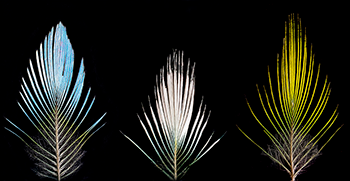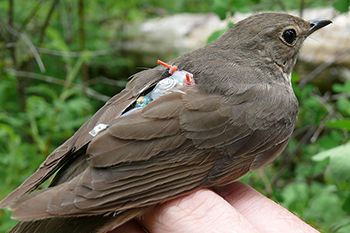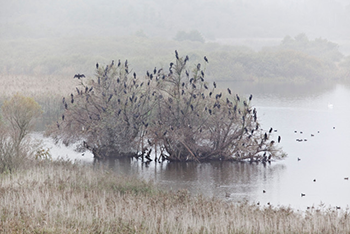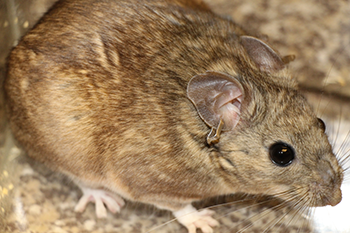Do Animals Try To Mate With Other Species
Deep in the Amazon rainforest live two green birds. The snow-capped manakin, has a splash of white on its caput. The opal-crowned manakin looks very similar. But this species' crown tin can appear white, bluish or ruby depending on the light. It's "similar a rainbow," says Alfredo Barrera-Guzmán. He is a biologist at the Democratic Academy of Yucatán in Mérida, United mexican states.

Feathers from the opal-crowned manakin's caput can appear blue, white or red depending on the light (left). The snow-capped manakin has white crown feathers (center). A hybrid species of the two, the golden-crowned manakin, developed a xanthous head (correct).
Univ. of Toronto Scarborough
Thousands of years ago, these two species of birds started mating with each other. The offspring initially had crowns that were slow whitish-gray, Barrera-Guzmán suspects. But in later generations, some birds grew xanthous feathers. This vivid colour made males more than attractive to females. Those females may have preferred mating with yellow-capped males rather than snow-capped or opal-crowned males.
Eventually, those birds became separate plenty from the 2 original species to exist their ain, distinct species: the golden-crowned manakin. Information technology'southward the first-known example of a hybrid bird species in the Amazon, he says.
Commonly, different species don't mate. Only when they do, their offspring will be what are chosen hybrids.
The molecules of DNA in each of an animal'south cells hold instructions. These guide what an animate being looks like, how information technology behaves and the sounds it makes. When animals mate, their young become a mixture of the parents' DNA. And they can end up with a mixture of the parents' traits.
If the parents are from the aforementioned species, their Deoxyribonucleic acid is very like. But DNA from dissimilar species or species groups will take more than variations. Hybrid offspring get more variety in the Deoxyribonucleic acid they inherit.
So what happens when the Deoxyribonucleic acid of two animal groups mix in a hybrid? At that place are many possible outcomes. Sometimes the hybrid is weaker than the parents, or doesn't even survive. Sometimes it's stronger. Sometimes it behaves more like one parent species than the other. And sometimes its behavior falls somewhere in between that of each parent.
Scientists are trying to understand how this process — called hybridization (HY-brih-dih-ZAY-shun) — plays out. Hybrid birds may take new migration routes, they found. Some hybrid fish appear more vulnerable to predators. And rodents' mating habits may affect what their hybrid offspring can eat.

Two bird species, the snow-capped manakin (left) and opal-crowned manakin (right), mated to produce hybrids. The hybrids eventually became their own species, the golden-crowned manakin (heart).
Maya Faccio; Fabio Olmos; Alfredo Barrera
Wise to hybridize?
Hybridization happens for many reasons. For instance, the territory of two similar types of animals may overlap. This happens with polar and grizzly bears. Members of the two groups of animals have mated, producing hybrid bears.
When the climate changes, a species' habitat tin shift to a new surface area. These animals may encounter other, similar species. The two groups may mate by accident. For example, researchers have plant hybrids of southern flying squirrels and northern flying squirrels. As the climate warmed, the southern species moved north and mated with the other species.
When animals can't find enough mates from their own species, they may select a mate from another species. "Yous have to make the best out of the situation," says Kira Delmore. She is a biologist at the Max Planck Institute for Evolutionary Biology in Plön, Germany.
Scientists take seen this happen with ii antelope species in southern Africa. Poachers had thinned out the populations of giant sable antelope and roan antelope. Later, the two species bred with each other.
People can unwittingly create opportunities for hybridization, likewise. They might put ii closely related species in the same enclosure at a zoo. Or equally cities expand, urban species may increasingly encounter rural ones. People may even set loose animals from other countries, accidentally or on purpose, into a new habitat. These exotic species now may encounter and mate with the native animals.
Many hybrid animals are sterile. That means they may exist able to mate, but they won't create offspring. For instance, mules are the hybrid offspring of horses and donkeys. Well-nigh of these are sterile: Two mules can't make more than mules. But a horse mating with a donkey can make another mule.
Biodiversity is a measure of the number of species. In the past, many scientists assumed that hybridization wasn't good for biodiversity. If many hybrids were produced, the 2 parent species could merge into i. That would reduce the variety of species. That's why "hybridization was frequently viewed as a bad thing," Delmore explains.
Just hybridization sometimes can boost biodiversity. A hybrid might exist able to eat a sure food that its parent species cannot. Or possibly information technology can thrive in a dissimilar habitat. Eventually, it could become its own species, like the golden-crowned manakin. And that would increase — not decrease — the variety of life on Earth. Hybridization, Delmore concludes, is "actually a artistic force."
Going their ain mode
Hybrids tin can be different from their parents in many ways. Advent is only ane. Delmore wanted to know how hybrids might comport differently than their parents. She looked to a songbird called the Swainson'due south thrush.
Over time, this species has separate into subspecies. These are groups of animals from the aforementioned species that live in different areas. Yet, when they practise run across each other, they tin still breed and produce fertile young.
One subspecies is the russet-backed thrush, which lives on the due west coast of the United States and Canada. Every bit its name implies, it has reddish feathers. The olive-backed thrush has greenish-brown feathers and lives farther inland. But these subspecies overlap along the Coast Mountains in western North America. There, they can mate and produce hybrids.
One deviation between the two subspecies is their migration beliefs. Both groups of birds breed in North America, then fly s in winter. Merely russet-backed thrushes migrate downwardly the w declension to land in Mexico and Fundamental America. Olive-backed thrushes fly over the central and eastern Usa to settle in S America. Their routes are "super different," Delmore says.

Scientists attached tiny backpacks (every bit seen on this bird) to hybrid songbirds called thrushes. The backpacks contained devices that helped the researchers track the birds' migration routes.
Chiliad. Delmore
The birds' DNA contains instructions for where to wing. Which directions exercise hybrids get? To investigate, Delmore trapped hybrid birds in western Canada. She placed tiny backpacks on them. A light sensor in each backpack helped record where the birds went. The birds flew s to their wintering grounds, carrying the backpacks on their journey.
The next summer, Delmore re-captured some of those birds back in Canada. From the sensors' light data, she figured out what fourth dimension the sun had risen and set at each point forth the bird's journey. The length of the 24-hour interval and timing of midday differs depending on location. That helped Delmore deduce the birds' migration paths.
Some hybrids roughly followed ane of their parents' routes. Merely others didn't take either path. They flew somewhere downward the middle. These treks, though, took the birds over rougher terrain, such as deserts and mountains. That could be a trouble because those environments might offer less food to survive the long journey.
Some other group of hybrids took the olive-backed thrush's route due south. Then they returned via the russet-backed thrush'due south path. Merely that strategy might as well cause issues. Ordinarily, birds larn cues on their mode southward to aid them navigate dorsum home. They might notice landmarks such every bit mountains. But if they return by a different path, those landmarks volition be absent. One result: The birds migration might have longer to complete.
These new information might explain why the subspecies have remained divide, Delmore says. Following a different path may mean that hybrid birds tend to be weaker when they reach the mating grounds — or accept a lower chance of surviving their yearly journeys. If hybrids survived as well as their parents, Deoxyribonucleic acid from the ii subspecies would mix more than often. Eventually these subspecies would fuse into one grouping. "Differences in migration could be helping these guys maintain differences," Delmore concludes.
Perils of predators
Sometimes, hybrids are shaped differently than their parents. And that can affect how well they avert predators.
Anders Nilsson recently stumbled onto this finding. He is a biologist at Lund University in Sweden. In 2005, his squad was studying two fish species named mutual bream and roach (not to exist dislocated with the insect). Both fish alive in a lake in Denmark and migrate into streams during winter.
Explainer: Tagging through history
To study their behavior, Nilsson and his colleagues implanted tiny electronic tags in the fish. These tags immune the scientists to rails the fish's movements. The team used a device that broadcast a radio point. Tags that received the signal sent back i of their own that the team could detect.
At showtime, Nilsson's team was interested only in roach and bream. Only the researchers noticed other fish that looked like something in between. The main difference was their body shape. Viewed from the side, the bream appears diamond-shaped with a taller middle than its ends. The roach is more than streamlined. It'south closer to a slim oval. The third fish's shape was somewhere between those two.

Ii fish species, the common bream (left) and roach (right), tin can mate to produce hybrids (center). The hybrid'south torso shape is somewhere in betwixt its parent species' shapes.
Christian Skov
"To the untrained heart, they simply look like fish," Nilsson admits. "Only to a fish person, they are hugely different."
Roach and bream must accept mated to produce those in-betwixt fish, the scientists thought. That would make those fish hybrids. And and so the team began tagging those fish, also.
Fish-eating birds called great cormorants live in the same area equally the fish. Other scientists were studying the cormorants' predation of trout and salmon. Nilsson's team wondered if the birds were eating roach, bream and hybrids too.

Here'south a roost for birds called cormorants. Researchers found that these birds were more than likely to eat hybrid fish than either species of the parent fish.
Aron Hejdström
Cormorants gobble fish whole. Later, they spit out unwanted parts — including electronic tags. A few years later on the researchers had tagged the fish, they visited the cormorants' nesting and roosting sites. The birds' homes were pretty gross. "They throw up and defecate all over the place," Nilsson says. "It'due south not pretty."
But the researchers' search was worth it. They found a lot of fish tags in the birds' mess. And the hybrids appeared to fare the worst. For their efforts, the team found 9 percentage of the bream tags and 14 percentage of the roach tags. Just 41 percent of the hybrids' tags as well turned upwards in the nests.
Nilsson isn't sure why hybrids are more than likely to be eaten. Just perhaps their shape makes them easier targets. Its diamond-like shape makes bream hard to swallow. The roach'due south streamlined body helps information technology chop-chop swim away from danger. Since the hybrid is in betwixt, it may non take either advantage.
Or maybe hybrids just aren't very smart. "They could be sort of stupid and not react to the predator threat," Nilsson says.
Picky mating
Just because scientists find hybrids doesn't mean the ii species will ever breed with each other. Some animals are choosy virtually which mates they'll accept from another species.
Marjorie Matocq studied this question in rodents chosen woodrats. Matocq is a biologist at the University of Nevada, Reno. She started studying California'due south woodrats in the 1990s. Matocq found these creatures interesting because they were very common, but scientists knew and so piffling nigh them.

The desert woodrat (shown here) sometimes mates with a similar species chosen Bryant's woodrat. Researchers have found that many hybrid offspring probably have a desert woodrat father and Bryant's woodrat female parent.
M. Matocq
In a recent study, her team focused on two species: the desert woodrat and Bryant'southward woodrat. Both alive in the western United States. But desert woodrats are smaller and inhabit dry areas. The bigger Bryant's woodrats live in shrubby and forested areas.
At a site in California, the ii species overlapped. The animals hither were mating and producing hybrids, but Matocq didn't know how common this was. "Is it just a hazard accident, or is this happening all the fourth dimension?" she wondered.
To find out, the researchers brought woodrats to their lab. They prepare tubes shaped like a T. In each experiment, the scientists placed a female desert woodrat or Bryant'due south woodrat at the bottom of the T. And then they put a male desert woodrat and a male Bryant's woodrat in contrary ends of the height of the T. The males were restrained with harnesses. The female person could then visit either male person and decide whether to mate.
Female desert woodrats almost always mated with their own species, the scientists institute. These females may take avoided Bryant'southward woodrats because those males were bigger and more ambitious. Indeed, the males frequently bit and scratched the females.
Only the female Bryant's woodrats didn't mind mating with male desert woodrats. Those males were smaller and more docile. "At that place wasn't as much danger," Matocq observes.
Scientists Say: Microbiome
The researchers suspect that many wild hybrids take a desert woodrat male parent and a Bryant'south woodrat mother. That could exist important because mammals, such as woodrats, inherit bacteria from their mothers. These bacteria stay in the animate being's gut and are chosen their microbiome (My-kroh-BY-ohm).
An animal's microbiome may touch on its power to digest food. Desert and Bryant'south woodrats probable eat different plants. Some of the plants are toxic. Each species may take evolved ways to safely digest what they chose to swallow. And their microbiomes may accept evolved to play a role in that as well.
If true, hybrids may have inherited bacteria that aid them digest the plants that Bryant's woodrats typically eat. That ways these animals might be better-suited to dine on what a Bryant's woodrat eats. Matocq'south team is now feeding different plants to the parent species and their hybrids. The researchers will monitor whether the animals get sick. Some hybrids might fare better or worse depending on their mix of Deoxyribonucleic acid and gut bacteria.
What'south exciting almost hybrids is that you tin can think of each one "every bit a piddling bit of an experiment," Matocq says. "Some of them piece of work, and some of them don't."
Source: https://www.sciencenewsforstudents.org/article/mixed-world-hybrid-animals
Posted by: wheelerrone1950.blogspot.com

0 Response to "Do Animals Try To Mate With Other Species"
Post a Comment